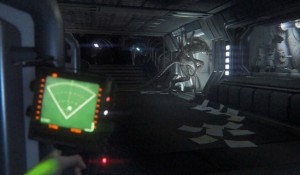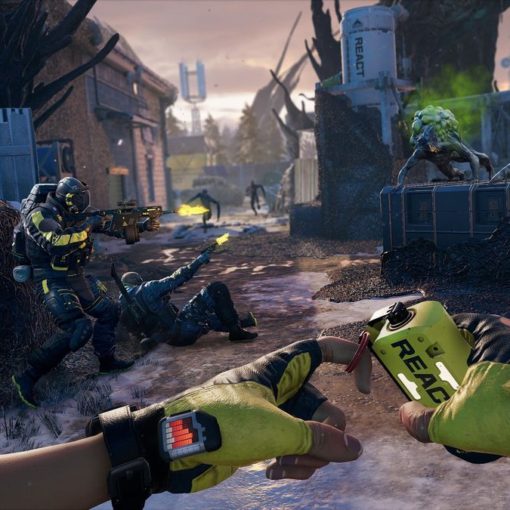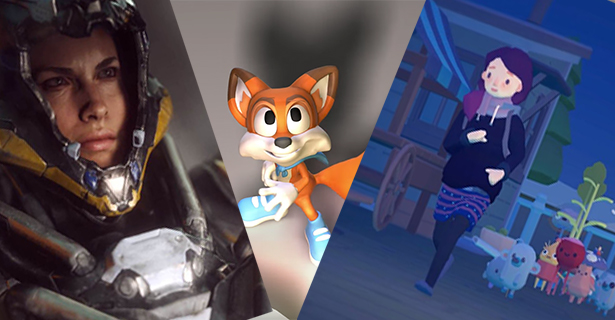Last October, Sega released Alien: Isolation, and much of the discussion around the game has dealt with its pacing, its level of difficulty, its relationship and faithfulness to the film franchise, and whether or not the game is successfully scary. Relatively little discussion has occurred, however, regarding the manner in which gender is represented in the game—something that, it seems to me, should be conceived of as significant, as Alien: Isolation is one of those rare games in which the main character is a woman.
I was really excited to play the game when it came out, especially since I, being fairly obsessed with Alien, was interested in the fact that the game allows us to think about what happens to Ellen Ripley’s daughter Amanda. But what happens to Amanda, I have come to realize, is emblematic of a larger issue—namely, the manner in which women are rendered invisible, and not just in video games or in the Alien films or in the horror genre but, more broadly, in a lot of different narrative and media forms. And specifically, it would seem that the way we are expected to play Amanda, the way we are told Amanda must navigate her way through the narrative of the game in order to reach the end and survive, is predicated on Amanda’s gender. The actions we take in Alien: Isolation, then, allow us to think about the ways that action—and inaction—become gendered.
The game, a survival horror stealth game played from a first person perspective, focuses on Amanda’s search to find information regarding the fact that her mother has been missing for the past fifteen years. This search leads her to Sevastopol Station, on which the flight recorder from the Nostromo (her mother’s ship) is being held. Upon arrival at Sevastopol, Amanda finds the station in disarray—the crew has been reduced to small, paranoid, and violent groups of scavengers, the android workforce abruptly kills people on sight, and (most terrifyingly) the towering Xenomorph of the Alien franchise prowls the broken-down halls of the deteriorating station. Finding herself in the midst of such an ominous and chaotic environment, Amanda’s main goal is simply to stay alive—to avoid being shot by a scavenger, strangled by an android, or impaled by an alien—and to escape the space station.
 This survival-oriented narrative results in fairly passive gameplay. Much of the time spent playing Amanda involves hiding in storage closets, crawling through vents, and crouching behind desks—all in the name of avoiding detection. While I understand the fact that, as a horror game (especially one that descends from the Alien series), Alien: Isolation might seek to increase the suspense and eeriness of its narrative through the strategic use of fear-based objectives like hiding and escaping, what I find difficult to grasp is why such objectives must be played through the figure of a woman.
This survival-oriented narrative results in fairly passive gameplay. Much of the time spent playing Amanda involves hiding in storage closets, crawling through vents, and crouching behind desks—all in the name of avoiding detection. While I understand the fact that, as a horror game (especially one that descends from the Alien series), Alien: Isolation might seek to increase the suspense and eeriness of its narrative through the strategic use of fear-based objectives like hiding and escaping, what I find difficult to grasp is why such objectives must be played through the figure of a woman.
Perhaps one reason is the manner in which fear has often come to be constructed on the basis of gender. Within the realm of film—and horror films, in particular—gender-based representations of fear seem to be especially prevalent (which Carol Clover discusses at length in Men, Women, and Chain Saws: Gender in the Modern Horror Film). Slasher films, for instance, rely on such representations through their featuring of terrified female victim-protagonists; the extended narrative of the Alien series—of which Alien: Isolation, although it is a video game, can be considered a part—also makes use of such fear-driven storylines and character development. And yet, the interplay between fear and gender in these horror narratives is not necessarily as cut and dry as it may, at first, seem because even though fear may be gendered feminine, the fact that victim-protagonists like Amanda are able to heroically rescue themselves also seems to allow them to inhabit more traditionally masculine spaces as well. To be sure, Amanda Ripley seems to occupy both gendered spaces—feminine abject terror and masculine self-rescue—throughout the game, as the objective of her continual hiding is, ultimately, one of resilient survival. But while Amanda’s embodied blurring of such gender binaries may seem promising, it is nonetheless apparent that Amanda embodies fear, and it would seem that Amanda’s female body has been deemed necessary for just such a representation of terror. As such, the use of the female form, here, just like the use of female victim-protagonists in the horror genre in general, seems to be a calculated choice in the representation and perpetuation of the gendering of fear.
It seems to me that such gendering is especially revealed through the way Amanda moves around Sevastopol Station and the actions she takes throughout her journey. Unlike characters in more action-based first person perspective games (like first person shooters), Amanda rarely has the opportunity to actually shoot anything. The androids are extremely difficult to kill (and often kill Amanda before she has a chance to retaliate), the Alien is impossible to kill, and the game specifically directs players to avoid detection or find a way around groups of human scavengers so as not to provoke them in a fight; Amanda, on the other hand, is surprisingly easy to kill, since she only seems to be able to take very light damage before meeting an untimely demise. Amanda’s biological difference is specifically invoked in such situations; indeed, one character, in directing Amanda to find a way around a group of scavengers, bluntly says, “You’re smaller than me—you’ll make less noise.” Thus, Amanda, through her gender, is rendered biologically smaller and weaker, thereby designating the actions of hiding, crouching, ducking, and crawling to be biologically relevant objectives.
 And further, the weapons (if we can call some of them that) that Amanda acquires throughout the game enhance such gendering. Amanda does not acquire a revolver for the first couple hours of gameplay, and even when she does, it is completely ineffective against the Alien, mostly ineffective against the androids, and inadvisable against the humans (as the noise may draw the Alien near). In the second half of the game, she does acquire a flamethrower, which, at least, hinders—but does not kill—the Alien (and often does not kill the androids before they have a chance to kill her). Most of the weapons that Amanda finds or crafts (from scraps found around the station) are distraction devices, such as flares or noisemakers that Amanda can throw down a hallway to distract her foes so that she can escape in the other direction. And, significantly, the main device Amanda uses is a motion tracker (modeled off the version used in the films) that allows her to detect the approach of a foe so that she might quickly duck into another room or hide in a cupboard—in other words, so that she might remain unseen. What is interesting to me about all these weapons and devices is the fact that they represent the action of a game, and in Alien: Isolation, it would seem that the prevailing action is hiding in fear and seeking to remain undetected and invisible.
And further, the weapons (if we can call some of them that) that Amanda acquires throughout the game enhance such gendering. Amanda does not acquire a revolver for the first couple hours of gameplay, and even when she does, it is completely ineffective against the Alien, mostly ineffective against the androids, and inadvisable against the humans (as the noise may draw the Alien near). In the second half of the game, she does acquire a flamethrower, which, at least, hinders—but does not kill—the Alien (and often does not kill the androids before they have a chance to kill her). Most of the weapons that Amanda finds or crafts (from scraps found around the station) are distraction devices, such as flares or noisemakers that Amanda can throw down a hallway to distract her foes so that she can escape in the other direction. And, significantly, the main device Amanda uses is a motion tracker (modeled off the version used in the films) that allows her to detect the approach of a foe so that she might quickly duck into another room or hide in a cupboard—in other words, so that she might remain unseen. What is interesting to me about all these weapons and devices is the fact that they represent the action of a game, and in Alien: Isolation, it would seem that the prevailing action is hiding in fear and seeking to remain undetected and invisible.
Again, yes, I understand that it makes a lot of sense to spend a good chunk of time hiding and cowering and running away in a game that aims to be terrifying, but I cannot help wondering (because I am an inherent fuddy-duddy and proud of it)—does the game presuppose that everything that is happening in it is scarier because it is happening to a woman? Or, to put this another way, would we be as scared if the character we were playing were a man instead of Amanda? And if the character were a man, would we expect the game to have him die as easily as Amanda, be able to find and use a gun sooner and more often, run head-on into the fray against the Alien horde? I honestly don’t know, but what I do know is that Amanda is not the only female protagonist in the horror genre, and such a representational pattern—a pattern in which the seeming fragility and vulnerability of the female body is highlighted and influences the way we think about the narrative unfolding in front of us—bears consideration.





12 thoughts on “Hiding in Plain Sight: The Gendering of (In)Action in Alien: Isolation”
Hi everyone!
I have to say I very much disagree with this interpretation on almost every level. First of all, Ellen Ripley has a daughter, Amanda, so canonically it make sense for the main character to be Amanda.
Second, I do not think that the method of game play should be interpreted because Amanda is a women, but rather how terrible Alien: Colonial Marines was. The movie Alien is a horror movie and the alien games have taken away that horror element for a gun and run. It completely took away any fear of the Alien as a menacing presence. This returns the Xenomorph into it’s rightful form as a perfect predator. It would have been the same old, boring, and less visceral experience to have this be a run and gun.
Amanda, I argue, is just as strong as Lara Croft in the reboot Tomb Raider. Maybe not as well developed, but certainly just as brave and resourceful. No one questions her when she takes the lead to trap the alien. She is a woman who is an ENGINEER, appropriately dressed, and no one questions her. She should be celebrated.
Interestingly enough, I don’t think that Bianca ever says that it doesn’t make sense for the main character to be a woman. What she is critiquing is the gameplay options that you have as Amanda. I also think that the overly involved stealth element of A:I was an interesting choice and one that I think also infantilizes her because those actions call to mind more the character Newt from the film who survives by hiding rather than Ripley who is much more assertive in her combat (and adding a level of depth to that is the fact that Ripley’s character was originally written as a man).
I also don’t think that Bianca is saying that it’s not a good thing that Amanda is a female character (or the main character) but is rather that there is something there to be critiqued and considered. Incidentally, I am personally unconvinced by the Tomb Raider argument because I found Croft a weak character until the very end of the game when (for me) she became the Tomb Raider that I had hoped for at the beginning of the game (even considering that this was her own bildingsroman).
” I also think that the overly involved stealth element of A:I was an interesting choice and one that I think also infantilizes her because those actions call to mind more the character Newt from the film who survives by hiding rather than Ripley who is much more assertive in her combat…”
I understand your reasoning here, but I think Alien: Isolation is a throw back to the first Alien movie, not Aliens, where the one time they try to outsmart the alien it doesn’t end well. It’s a return to the horror and tense pacing of the first Alien rather than the action-oriented Aliens.
I don’t know, I really liked the game play options. The bolt gun and shot gun are very effective at killing the androids and the resistance to killing humans, I think, is less because she’s a woman (though the game does specify that she’s not a violent person) but rather it’s a sure way to get yourself killed by the alien. It’s also possible to be cruel and crafty. I used the noisemaker to lure the alien to kill humans while I made an escape.
I think that if someone thinks that the game is scarier because it’s happening to a woman instead of a man is not a failure of the game but a failure of the person playing the game. If I do add a critique of Alien: Isolation, it’s that you’re not reminded enough that Amanda is a woman. I found it a completely immersive experience and forgot that I was even a character at all. I just thought it was ME in there.
Welp, all I know is all the back and forth is making me actually want to play it, so…..
arp, in terms of gameplay they are similar so far, but I’m not that far into outlast. Honestly I keep expecting the AI to be just as good as Alien so when I outrun someone in Outlast I’m a little disappointed.
Having been interested in this game for a while, I really enjoyed this read. I wonder how the stealth heavy gameplay compares to male protagonist games like Outlast and Amnesia. I ask because at least Amnesia has maybe an hour played for me because it creeps me out too much and don’t own Outlast. Then again I usually play at night in dark with headphones by necessity.
Hence my lack of knowledge of much of either game.
I’d like to say I think you’re interpreting the game in the wrong context. The game is not supposed to be like Aliens. It is supposed to be like the original film, Alien which was vastly different from its sequel.
From the article you seem to be thinking of primarily the second Alien film titled Aliens which was less of a horror film and a lot more action like a Stallone or Schwarzenegger film. That is the wrong film to compare it to. Alien: Isolation was a love letter to the original Alien in which the lone Xenomorph was an indestructible monster.and was basically a slasher film set in space. And Isolation takes more inspiration from it.
I am not saying your interpretation is wrong but I would like to hear your thoughts with the intended context.
I would also like the point out Amnesia, its sequel Machine of Pigs, and Outlast. These three games have four male protagonists and one female one and have no weaponry what so ever so your only choices with encounters are to hide or run, no driving them off.
I would like to hear if this affects your thoughts as well.
Interesting read on the game
A Man? Duh!
Compulsive snarkiness aside, this author’s criticisms of modern electronic game is the bipolar nature of story vs game activity. Story, seems to exist in exposition only, sans narrative. Character development resembles the medival miracle plays where characters are fixed in development, exhibiting the character arc of a Steven Seagal movie, sans teeth, sans eyes, sans everything.
Jacques-u-lar comments aside, it is the play of the game that becomes the play. The activity of survival, evasion and escape (see US Army Manual FM 21-76) of the protagonist, from one of the best creatures developed for the silver screen, is the story, and the point of the discussion.
To that point, gender stereotyping for benefit of reaching a “broad” market, defeats the potential of the genre, delivers little in meaningful story enjoyment, keeping electronic games on the shelf of processed items such as Twinkies.
Only when the authors of such games invent their own narrative, rather than borrow the narrative of the cinema, will the electronic game grow into its own form of drama, and be a true work of art.
Hmm, that’s an interesting take on the game. It’s not really something I had considered, mostly because I consider Amanda a blank slate of a character and thus who she was didn’t mean much more to me than the protagonist of Amnesia or Outlast did (similar games with similarly bland leads).
Also though I feel like if the game had been designed to be more action oriented it might have ended up ringing false. It’s a game that wants to be Alien, and in that film Ellen Ripley survives much the same way Amanda does: hiding and being smart, rather than attempting to fight something she doesn’t understand. I guess perhaps that might beg the question of whether the original Alien was gendered as well, but that’s a different discussion.
On the whole though I feel like my interpretation of Amanda’s role would probably have been a positive one rather than a continuation of a negative trend, as to me it seemed to demonstrate that just because you’re physically week doesn’t make you helpless. She’s able to survive because she’s smart and confident in herself, being able to keep a level head and figure out a plan rather than charge forward guns blazing like so many of her cohorts. The alien has always been recognized as something nobody can stop, be they man or woman, and it’s in accepting this and moving past it that Ellen/Amanda are able to find ways to defeat it. To me I think it takes a lot of strength to recognize when you’re outmatched, and makes Amanda seem like a much more human character than the bullet sponges that fill most games (though I definitely think we should see more female characters in these roles too; I’d love a game where we played as someone like Vasquez).
It’s an interesting discussion to be had for sure, even if Isolation wouldn’t be my first choice for an example.
I think there are some good points here, and as a designer I’d like to think about potential ways to fix this.
Comparing this to Amnesia: The Dark Descent, Amanda is already stronger than Daniel. (Some Amnesia spoilers.)
1. Neither of them can kill the monster.
2. She can look at the monster without going insane. Daniel is forced to hide and look away or else be driven mad.
3. Amanda’s got way better morals than Daniel.
4. She can create things to use against the monster. Daniel can throw rocks (or so I’ve heard, I’ve never actually tried it).
So, already this is a stealth game with more tools at your disposal, but there’s a lot more combat involved too. So perhaps a comparison to a combat stealth game would be more appropriate to determine appropriate tools.
Let’s compare it to Hitman instead, especially around tools.
Hitman has his guns, silencers, syringes (knockout and poison), bombs and garrotes. Definitely more tools from that arsenal could have been included. A garrote might ruin the “limited ammo” feel, but why no offensive syringes with the medkits? Why no silencer upgrade to the gun?
And while 47 was certainly not the best bullet sponge, he was definitely way tougher than Amanda. I agree that the gender influenced the game. It would be interesting to see what the game could have been with a more rounded approach to mechanics.